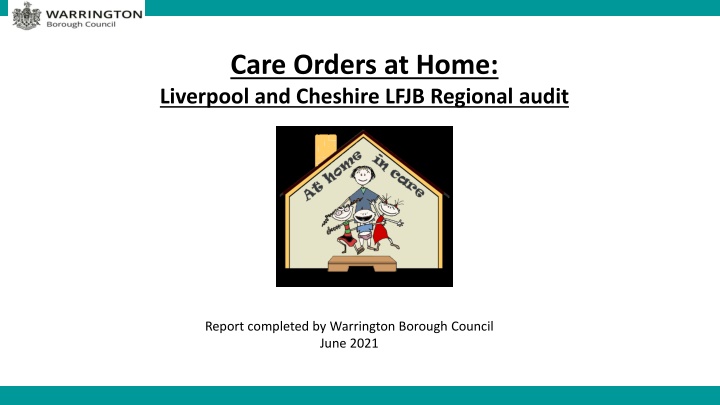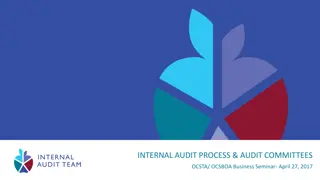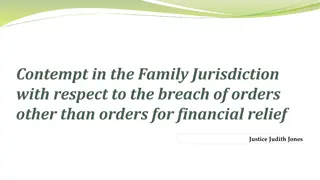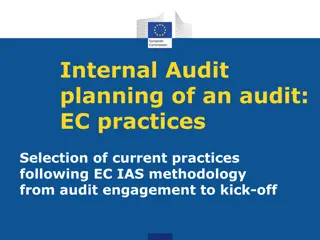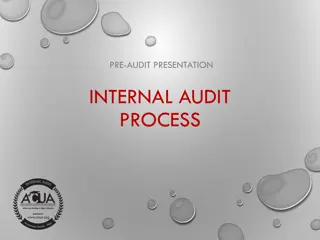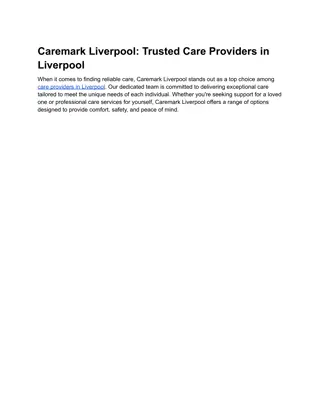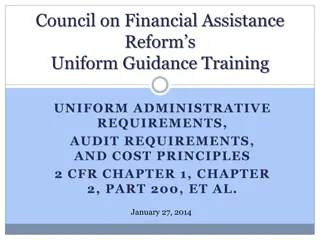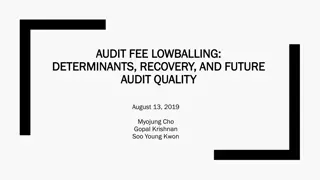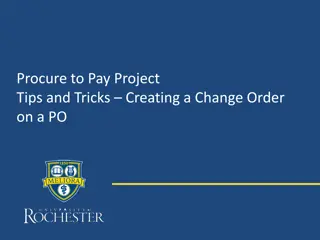Regional Audit Report on Care Orders at Home in Liverpool and Cheshire - June 2021
LFJB Regional audit report completed by Warrington Borough Council highlighted the high number of children living at home with care orders in the North West region. The report focuses on the period between 2017 and 2021, aiming to identify common themes and lessons across local authorities. The method involved data analysis and audits on areas like age of the child, pre-proceedings, legal status, assessments quality, communication, and discharge of care orders. The report also requested data on care orders at home for specific dates and outcomes, including placement success and adoptions.
Download Presentation

Please find below an Image/Link to download the presentation.
The content on the website is provided AS IS for your information and personal use only. It may not be sold, licensed, or shared on other websites without obtaining consent from the author.If you encounter any issues during the download, it is possible that the publisher has removed the file from their server.
You are allowed to download the files provided on this website for personal or commercial use, subject to the condition that they are used lawfully. All files are the property of their respective owners.
The content on the website is provided AS IS for your information and personal use only. It may not be sold, licensed, or shared on other websites without obtaining consent from the author.
E N D
Presentation Transcript
Care Orders at Home: Liverpool and Cheshire LFJB Regional audit Report completed by Warrington Borough Council June 2021
Purpose and method Purpose The LFJB are aware that the North West region, and Cheshire and Merseyside as a sub region, are an outlier in terms of the numbers of children living at home with their parents/person with Parental Responsibility (PR) whilst subject to a Care Order. PwP Q2 statistics highlighted that in 2019/2020, the North West had the highest number of Care Orders at home in comparison to other regions with 13% of all looked after children being placed with parents in the North West in comparison to London with just 2% In March 2021, the LFJB agreed to undertake a local review of Care Orders at Home to see if there are any common themes and lessons, that can be learnt across the practice and judicial system The Local Authorities came together, supported by CAFCASS, to better understand the broader regional picture of care orders at home; focusing on the period between 2017 and 2021 (an audit had been completed in 2017 by the North West Association of Directors of Children s Services (ADCS); as such any similarities or changes in findings will be noted) Method Each authority that took part was asked to prepare a data set (see slide 3 where made available) and complete a number of audits of cases to gain a more narrative understanding of what may be influencing the use of Care Orders at Home. Local Authorities (LA) were asked to consider a number of areas in the individual audits comprising; age of the child at the time of the order being granted; whether the family had been subject to Pre-Proceedings (PPP); the current legal status; the number of assessments and quality of these; quality of communication between professionals; how the LA exercises PR, and whether the Care Order has been discharged The emerging themes and questions posed are detailed within this report Due to different recording systems and numerous reporting differences across each Local Authority, not all areas of the initial data set could be analysed; however data from each authority has been drawn upon throughout to evidence themes
Data requested and analysed How many Care Orders at Home has each LA had on the following dates: 31/03/2017 31/03/2018 The following were felt to not be readily available in LA authority data sets: How many ICO s at home were a result of private proceedings, and not a LA led care application? 31/03/2019 31/03/2020 31/03/2021 How many ICO s at home were to support placement in, for example, a parent assessment centre how many of these proved successful in the child remained with parent following placement? How many were discharged in favour of a Supervision Order? How many ICO s at home resulted in FCO s at home? Current legal status? (still at home subject of CO/SGO/Adopted/placement order/turned 18 etc.) If still at home how many CO have since successfully been discharged? How many have been removed and placed for adoption? How many have been removed and placed with alternative carers but not adopted/placed for adoption?
Number of Care Orders at Home between 2017 and 2021 by Local Authority (S.31 and S.38) 2017 2018 2019 2020 2021 185 183 176 170 138 113 113 110 107 92 91 87 85 83 82 80 77 77 74 67 64 62 61 56 49 46 46 46 42 41 WIRRAL LIVERPOOL CHESHIRE WEST ST HELENS CHESHIRE EAST WARRINGTON
All of the 6 authorities drawn upon in the graphs have an increase in Care Orders at home this year (2021) TOTAL NUMBER OF CARE ORDERS AT HOME ISSUED ACROSS THE 6 LOCAL AUTHORITIES 595 572 556 600 Although the figures don t appear to have increased by a significant number, they have been generated in May 2021; therefore are not yet representing the full year. It could therefore be surmised that although it is likely some will be discharged, there is a significant increase in Care Orders at home already this year. This has been evident in Warrington where there were 29 new Care Orders at Home in 2020 and in 2021 thus far, there have already been almost double at 46 498 482 500 400 300 200 100 0 2017 2018 2019 2020 2021 Has there been an increase in the past year due to the impact of Covid 19? (This will be explored on the next slide) Total number
Influence of Covid 19 on the issuing of Care Orders at Home Questions to consider Are professionals; both court and social care, being more risk averse due to a worry that children haven t been seen as frequently and not in person, and therefore not feeling as confident in decision making? Has the impact on court availability and capacity impacted on Care Orders at Home being more readily issued or to prevent drift in permanency planning and meeting PLO (Public Law Outline) timeframes? (The influence of the PLO is explored further on slide 11) Are professionals feeling that they need longer to evidence risk, impact and change; particularly in families where neglect is prevalent and where professionals may not have been felt to have visited enough? There have been instances where families are believed to have used Covid and isolation to prevent professionals visiting face to face. Conversely, there have been times when the social worker has had to shield or isolate and has therefore been unable to visit or duty workers visiting who don t know the family. This can make it more difficult to evidence harm and complete necessary assessments in a timely manner There have been queries posed by social workers during the audit about how frequently guardians are seeing the child and family, with some stating that they didn t think the Guardian had seen the child at all during the Covid pandemic. There was a perception that this may be only once on many occasions prior to Covid, yet evidence of court decisions is that they are positioned as the expert and more weight given to their opinion within court. Although there are no statutory requirements for CAFCASS Guardians visiting children however there is work ongoing to develop practice standards and expectations It would be interesting to see what the reason for issue has been with these placements at home and whether the type of issue appears to influence the order being granted
Is it the LA who are requesting Care Orders at Home or are court over ruling? It was apparent in the audit, that it is not always easily determined as to whether a court has over ruled or whether the LA has opposed the plan; nevertheless, from analysing the data, it appears that it is the court overruling LA s in the majority of cases 5 of Cheshire West s 10 audits had a recommendation of Supervision Order (SO) but none were agreed with, with the court favouring a Care Order at Home In only 3 of the cases was the outcome the same as what Cheshire West had requested the other s were 5 SO s resulting in Care Order at Home, 1 a Care Order and placement order requested and the other a Child Arrangement Order, but all were Placement with Parent In the Wirral, in 8 out of 9 cases audited, the final decision wasn t in line with the initial LA care plan; for instance 2 were requesting SO s and 6 had requested removal initially but not granted (in 3 of these the removal was granted initially but then final plan was place with parents if threshold is then not met after proceedings, should it be a supervision order? This is explored further on the next slide) LA s seem to request a Care Order at Home due to social care not having the confidence that they can avoid/win an argument when other parties recommend a Care Order at Home. This was seen in a Warrington case where the court documents stated the LA were requesting a Care Order at home but in supervision documents and case notes, it was clear that it wasn t actually what the LA thought should happen but because of the influence of the guardian. A case example of this is provided below. Liverpool case (BM) Whilst the LA did put forward the care plan Care Order at Home, this was submitted in the knowledge that the Court would be unlikely to grant a Supervision Order, or that the Guardian wold agree to the lesser order. However if there had been a Supervision Order that had a higher remit than advise, assist and befriend, that could have been requested and the Court would have had more confidence in robust oversight by the LA.
Supervision Orders Care Orders at home appear to be favoured more over Supervision Orders. Where the LA care plan was Supervision Order (SO) a Care Order at home was regularly granted instead; for example as well as Cheshire West s audits requesting SO s in 5 out of 10 cases and none being granted, the Wirral had also asked for a SO in 2 of their cases with neither being granted. It would be interesting to see whether there is a pattern in respect of which judges have a tendency to disagree with SO s in favour of CO s and why this may be? Liverpool found that 86% of their placements with parents have been successful; however reported that their audit findings suggest that this would have been the case if a SO had been granted rather than a Full Care Order The Assistant Director of Liverpool children s services who completed the audits stated that Most of the cases could have been managed via a Supervision Order. Anecdotal evidence is that social workers put forward care Plans for PwP with a Care Order as they hold the firm belief that the Court and the Guardian will not consider any lesser order. At least 4 of the 9 audited by Liverpool had noted that a SO could have sufficed One of the primary reasons for this is the LA not having needed to exercise PR after the Care Order was made in some cases with the parents co-operating, so arguably if there isn t the need for the LA to hold responsibility for the child, there isn t the need for a CO Is there is a reluctance from the Court and Guardian to issue Supervision Orders? There was evidence that social work teams frequently asked for a contested hearing to take place, however in reality this never happened. Anecdotally this is reported as due to discussions taking place on the day of hearings/outside of Court and pressure being applied to settle a case rather than progress to contested hearing. All too often social workers and managers reported pressure being applied to change care plans, resulting undoubtedly in more Care Orders at home being made Why do LA s not feel empowered to stick to original care plans in this context? On the next slide the benefits and constraints of the Care Order at Home versus the Supervision Order are presented, which has been based on the findings in this audit and specific families audited, with more context and case examples provided on slide 10 Number of Care Orders at Home (S.31) discharged in favour of SO s 140 120 117 100 100 80 88 78 60 40 20 33 27 21 25 14 19 0 2017 2018 2019 2020 2021 Total discharged Discharged in favour of SO The above graph highlights the low number of Supervision Orders that are used when discharging the Care Order, with data being taken from 4 authorities. In total over the 5 years, it equates to 25% of Care Orders being discharged in favour of a SO 2021 is looking more promising in the use of SO s as the Wirral have so far this year discharged 58% of their Care Orders in favour of SO s
Care order at home Supervision Order (SO) Benefits Constraints Benefits Constraints LA to be able to assess any continued risk and ensure change is sustained Arguably if it is used to monitor or test a parents ability to sustain change once risk has reduced, it is disproportionate to have a Care Order as threshold is no longer met - If the level of risk is high enough to warrant a Care Order, then the child is arguably not safe to remain in the home where the high level of risk remains. If it isn t so high that the child can remain in the home then a Care Order being the most appropriate order is questionable Child continues having a social worker to support and undertake any further intervention as required, reassuring family, social care and court Family are still subject to visits and meetings which they could refuse to engage with Proceedings are more likely to conclude quicker with less drift as parents are less likely to contest a SO over a Care Order LA s don t hold PR the parents do, so the LA would not have as much influence over decision making but as mentioned, the LA having PR has not been found to be significant in cases where there is a CO and if a SO is being granted then LA shouldn t need to be so involved in decision making For LA to be able to exercise PR for the child and make decisions where necessary This is often not demonstrated with the majority of LA s feeling that the same tasks that the LA carry out as a corporate parent, could have been on a lesser order; such as SO, particularly if the SO was more robust Supervision Orders can lapse if they are no longer needed, or can be extended if a further period is necessary Not being seen as robust at times as managed under Child In Need level Parents are less likely to agree with a Care Order over a SO which can lead to further contested hearings and lengthier proceedings Care Orders remain in place until a child is 18 unless discharged. In this time the child is a child in care which can bring stigma and impact on a child s identity. Discharging an order can be very timely A SO is time limited so is more respectful to the right to family life as families only have intervention until the specified timeframe which is usually a year *Based on the findings from the case audits
Is there not enough confidence in the remit of the SO? Do we need a strengthened and consistent approach to SO s and SO support plans; for instance following a similar plan to that of Stockport s where the plan is detailed and broken down by month. Do we need to utilise a working group to agree a plan to use across all authorities and then send it to CAFCASS to get their views so there is reassurance as to the robustness of a SO? Does the court have faith in the IRO role and oversight in SO s? How could this improve? Does work need to be done with IRO s in each authority and their views on SO s in place of Care Orders? This is because according to the Quality Assurance and Safe Management of Supervision Orders Consideration of a Supervision Order will be part of the discussions during proceedings. The allocated IRO for the Looked After Child, should ensure the local authority considers and outlinestheir decision within the context of Re BS before agreeing the Final Care Plan at the Looked After Review. In the case of Cheshire West it could be said that this is occurring more often as they had requested a SO in 50% of theirs audited, but are we confident in this across all authorities? The Quality Assurance and Safe Management of Supervision Orders guidance also states that Without a detailed and focused plan, confidence can be affected as to the value of such an order and therefore the value of the approach recommended. This links with the communication findings on slide 12 and suggestions where a more linked up approach between SW, Guardian and IRO including the Guardian attending meetings, could offer more reassurance as to the value of a SO. The more relationships are built, perhaps the more reassured the guardian would be Are LA s confident in our universal services that any further concerns would be flagged up to further reassure on a Care Order not being needed? Why are legal advocates not accepting instructions from LA s but pushing back and concurring with advocacy from other parties? When LA requests Care Order At home it is often when changes have been made during proceedings but the LA want to be able to see sustained change and this not always being felt to be long enough during the child s timescales LA being risk averse and using a Care Order to assess/monitor progress of parents? It is agreed that there can be the need for further intervention and periods to assess; particularly in the Liverpool case AK, where the mother had children removed previously and the child had not been in her care very long, but is a Care Order then disproportionate if for monitoring purposes? Discharging a Care Order being timely: Case example Discharging the Care Orders has been found to take up a significant period of time in many cases and takes up significant resources for both court and social workers; whereas SO s can just lapse if not needing to be extended. Case of KC in Liverpool 1 sibling was granted a CO with grandparents (against LA plan) and the other 2 a Supervision Order with their father the siblings with their father are now closed to social care with the SO lapsing and the children doing well; whereas the other sibling who is also said to be thriving in the grandparents care, and was before the Care Order was granted, is still waiting for the Care Order to be discharged so still has the stigma of being a child in care unlike the sibling
Is a Supervision Order more favourable to No Order? OUTCOME OF DISCHARGES OF CARE ORDERS AT HOME (LIVERPOOL) No order would be more favourable if the risks have been reduced and threshold for a court order hasn t been met; however as this audit has found, often a Care Order at Home is being used as a form of monitoring and assessing a family when changes have been made but a longer period of evidencing change is felt to be needed. As such, these are the cases where a SO would be more favourable than No Order and a Care Order at Home This is because they don t necessarily meet threshold for a Care Order; particularly when the LA isn t evidencing the need to exercise PR, but there is a need for a period of intervention and assessment to provide reassurance to all parties that the child is safe The SO should run alongside complex Child In Need (CIN) planning so there would be a robust plan of support but with parents being able to make full decisions for their child without the unnecessary long term intrusion in to their family life If we grant a Care Order at Home when a lesser order such as a SO would be more proportionate, it could be interpreted as breaching Article 8 of the Human Right s Act as it would be intruding in to family life and labelling a child a child in care; albeit with their parents, but without due cause A SO still provides the power of safeguarding a child, but without the draconian approach of taking decisions away from parents and families, and leading to them feeling constantly threatened that their child could be taken away at any point It s not that a SO is more favourable than No Order, it s just more favourable to a Care Order at Home due to the impact it can have on children as outlined on the next slide No Order SO Family Assistance Order 1% 27% 72% The above statistics are over a 5 year period where 72 out of 100 discharges of Care Orders at home made, resulted in No Order This poses the question of whether a Care Order was needed in the first place and whether a SO or No Order could have been made instead Only 6 cases were re-referred resulting in short-term intervention with no child re- entering care
Feeling marginalised which can be particularly damaging to adolescents who are in the process of engaging with individuation from their families and building their identities further through their social support networks For children in care, bullying can be seen as the manifestation of stigma. Research has highlighted that they experience higher rates of bullying than other children Impact of being a child in care Children can perceive themselves as different once they are deemed as in care Being labelled as a Child In Care can lead to internalisation of stigma which can result in feelings of shame and guilt, with long-term consequences Feeling scared that they will be removed from their parents care at any time, leading to anxiety and attachment difficulties Children who are looked after have more emotional and behavioural needs than the general population of children Intrusion in to family life
Impact of the Implementation of the PLO The following data suggests that the pressure of remaining under the 26 week timescales could be leading to increased Care Orders at Home Warrington data comparison: Number of Care Orders at Home Pre and Post Public Law Outline (PLO) Pre PLO figures: 84 Care Orders at Home were issued in the 5 years before PLO was implemented in 2014 (between 2009 and 2013) Number of Care Orders at Home 107 85 82 Post PLO figures: 413 issued in 5 years after, between 2017 and 2021 77 62 Analysis: 26 This equates to a 392% increase since the PLO was implemented 18 17 12 11 2009 2010 2011 2012 2013 2017 2018 2019 2020 2021
There have been more CO s at home issued in 2021 to date, than there were over the whole 5 years before the PLO came in to force It must be acknowledged that the overall figures would need to be analysed as there could have been lower numbers of proceedings in general; however these statistics could indicate that the pressure of making decisions within these reduced timescales on social workers and the courts, is leading to an increase in CO s at home being requested and granted and trying to balance decisions being made within the Public Law Outline (PLO), and also the correct decisions being made to ensure long term safety and wellbeing of children The findings add more weight to courts extending beyond 26 weeks where it is right to do so
Professional communication and challenge In the audit by the ADCS in 2017, an emerging theme was the need for improved communication between Social Workers (SW), IRO s and Guardians, and 5 years on there does not appear to have been significant progress as this was also an emerging theme in this audit Although Liverpool did find in some cases that there was improved communication between SW and Guardian when discharging a Care Order, in the main there was limited evidence on LA case files of communication between the social worker and the guardian between hearings. There was more evidence of conversations between the IRO and guardian, though this was still limited and infrequent Some found that if there is evidence of communication with Guardian s, is not until near the end of proceedings or they reserve their position until the day of hearings leaving no time to understand, challenge or discuss their positon when it differs from the LA. CAFCASS managers have an expectation that guardians give a clear rationale where there is a difference of opinion, it would be expected that this is shared at the earliest opportunity and throughout the duration of proceedings as required The pie chart opposite is focused on Liverpool LA s completed audits where 8 out of the 10 files audited showed little or no communication between SW, IRO Guardian (3 had some communication between the social worker and IRO but none with guardian) 2 files had some record of communication with 1 being described as extensive In the Wirral audits, 4 out of 9 had visible communication between Social Worker, IRO and Guardian Warrington had good evidence of IRO footprint; however in none of the files audited was there a record of communication between the Social Worker and Guardian. This is not to say that it didn t take place, but there was no record of it Some suggestions for improving communication in practice is presented on the following slide
Clear rationale for decision making and challenge. If decisions aren t agreed with, challenge should be demonstrated via the correct channels as early as possible; not care plans automatically changed. Look at improving the escalation process between LA s and CAFCASS Make contact with the guardian/IRO/Social worker as soon as a child is subject to court proceedings does work need to be done with SW s on how they find out who the allocated guardian is? Responsibility on all to contact one another and build relationship as early as possible Should Guardian s be invited to, and attend child in care reviews? It could strengthen relationships and communication, allow opportunity to challenge earlier or be reassured by support and permanency plan and discuss possible SO Strengthened communication Social worker Guardian IRO Redress power imbalance moving away from a single professional as the sole expert Improved case recording to reflect discussions held - Recording of all discussions between social worker, guardian and IRO need to be entered onto child s file including emails LA needs to work on advising practitioners and CAFCASS to advise Guardians. Consider disseminating findings of this audit to highlight
Number of assessments Many case audited were subject to a number of addendum and positions statements; Independent Social Worker (ISW) reports and specialist assessments and it was often not clear why they were needed. The number of assessments requested during proceedings in those audited ranged from 2 to 9 Expert reports being requested during proceedings can cause delay, especially if further down the line in the 26 weeks as it takes time for professionals such as psychologists to be identified and then assessments completed. The outcome of the expert reports can push back proceedings to allow for further social work reports to be completed reflecting the results of the expert reports, and this can be a continued cycle that each time is further delaying permanency for the child In an independent audit of care proceedings completed by Warrington Borough Council in January 2021, the number of assessments requested was a factor in social workers feeling overwhelmed and drift in proceedings and an example of one such case is presented opposite The use of ISWs was queried and led to questions about whether the SW was seen as an expert and if their opinion is valued. What triggers an ISW report? Parties feeling that social work evidence is not strong enough? Not agreeing with care plan? Capacity of social worker? Struggling with relationship with parent and so needs independent worker? There needs to be a clear reason as it has been found that it can be invaluable but in other cases it can confuse matters with too many views and contradictory outcomes. This was the case with a Liverpool family (RC) The quality of assessments from the social were said to be good and evidenced based and a psychiatric assessment had been completed but then the ISW report is said to be Poor quality. Confusing as concludes that mother has the ability to meet the children s needs and then quotes psychiatrist regarding her propensity to remain in domestic abusive relationships and states that children should not be returned home. It is evident that mother has not engaged in the assessment and the ISW makes repeated statements about this lack of interaction but fails to provide any insight or analysis as to why this might be. Case example JW There were just under 20 witnesses in total due to the high number of expert witnesses called upon Different judges and different hearings lead to different recommendations which in turn led to further assessments being requested An ISW assessment was then requested despite all of the many previous asseessments completed, adding further delay The social worker felt that with each judge and each assessment/expert requested, the information became diluted and whether this then leads to ISW s being called upon
Are Courts providing sufficient rationale for repeat assessments and is there enough scrutiny of the need for additional assessments? It is accepted that there are cases where a number of different assessments are required and the situation of the family can change during proceedings which then warrants an addendum assessment, and in Liverpool case (KC) an ISW completed a together or apart assessment which was thorough and took a lot of time with the children. However the more assessments that are requested, the more diluted the content arguably becomes as with the case of JW. Do families then lose faith and trust in those undertaking the assessments leading to increased contested hearings, resulting in even more addendum assessments or ISW reports? Are we creating a culture of start again syndrome and parents knowing the right thing to say due to having so many assessments and differing outcomes? How much weight do court put on the outcome of the ISW assessment versus LA? There was a sense in cases reviewed that ISW s took more on face value self reporting of parents, which was then given credence in court, and resulted in a Care Order at home being made Do judges/guardians see examples of good practice that they can share? Warrington are having a push for legal and team managers to disseminate examples of good practice to improve overall quality of reports and assessments; such as initial statements. Should LA s push for examples of good practice to be disseminated in their authorities. Consider peer review of initial statements across LA s
Pre Proceedings (PPP) An emerging theme for the group was the influence and link between Care Order at Home and pre-proceedings The data from each authority was variable in terms of whether the family had previously been subject to PPP before proceedings were issued, with 4 out of 6 audited in Cheshire West being subject to PPP, but 7 out of 9 not having been in the Wirral There was an acceptance from the LAs that where pre-proceedings had not been used prior to issue, this should have been considered on many cases; for instance Liverpool found that where there had been trigger incidents that warranted removal, pre proceedings had not previously been entered into and should have been For those who were subject to pre-proceedings there were questions regarding the quality of initial evidence (SWET) particularly in terms of how the social worker had built on and reflected the work already undertaken during the pre-proceedings process, this lead to a sense of repeat assessments; for example parenting assessments. There was a case audited in the Wirral (JM) that had been subject to pre proceedings yet there were 6 separate assessments during proceedings. It was not always as strongly evidenced as possible about what work and interventions has already been provided during pre-proceedings which could be why a significant number of removals were not granted, in place of a placement with parent. A case study opposite illustrates this Case example: Link between thorough PPP, number of assessments, communication between professionals and joined up decision making AK (Liverpool) Although it was felt that PPP could have been entered earlier, it was thorough including cognitive and psychological assessments; parenting intervention, drug and alcohol testing, and the initial statement from the social worker was strong. The court agreed with the initial plan for the child to be in foster care in this case and there were only 3 assessments required during proceedings; a PAMS assessment and position statements . This was also a case where communication between SW, IRO and Guardian was described as extensive, adding further weight to the theory that strengthened communication throughout, can lead to a more joined up approach to decision making Therefore is a strengthened PPP process needed to enable courts and guardians to be more confident in the LA s care plan?
The quality of the SWET and it potentially not representing the work completed or attempted with a family during pre-proceedings has led to questions over whether an additional document would be beneficial; such as a pre-proceedings summary to fit alongside the SWET. However given that a significant issue within LA s is capacity of social workers and the pressure of the aforementioned number of assessments that are required of them, it could be contradictory to recommend reducing addendum assessments and expert assessments, and then add another document in There arguably needs to be a focus on the quality of the SWET itself and perhaps some guidance and good practice examples shared within LA s to improve the quality of the SWET, with an emphasis on summarising what has been completed within pre-proceedings. For example Warrington are rolling out a new programme of legal training from September where writing a good, evidence based SWET could be included in that Do all LA s use the same SWET template? If so, it could also be suggested to add in a section to summarise PPP how long, work completed, attempts made to work with the family etc. It could feel less overwhelming for social workers to have the same form but remind them to be clear on including work during PPP Do court have faith in the LA s PPP process on the whole? What is their understanding of what should occur in PPP? Do they think this is taking place? What do they think could be improved? It appears that poor use of pre proceedings is it a good indicator of a LA being unlikely to get removal and more likely for a Care Order at Home to be granted instead. How do we promote more cohesion between PPP and proceedings where proceedings are viewed as an extension of PPP rather than a separate process? Should LA s propose how they intend to strengthen/audit their PPP process? Warrington are due to complete an audit of PPP and it s effectiveness should other LA s follow suit and share findings with CAFCASS? There is a need for robust chronologies has been found to be fundamental; firstly to be able to identify repeat patterns of behaviours and social care intervention to be able to identify PPP needed earlier and prevent start again syndrome. This was evidenced in a Liverpool case (DD). It was felt that pre proceedings should have been entered much sooner as there was four years of child protection planning which was ineffective. A comprehensive chronology would have highlighted the start again approach that was used and robust managerial oversight should have identified the need for a higher level of intervention.
Conclusion Overall the findings appear similar to those reported in the ADCS audit in 2017 There has been an increase in Care Orders at Home in all 6 authorities in 2021 There is a dearth of Supervision Order s utilised across the North West, which could be due to an increase in risk averse practice; resulting from Covid 19 and also the implementation of the PLO and subsequent time pressures to conclude proceedings There is inconsistency across the region with regards to the use of Care Orders and Supervision Order s, with some using Supervision Orders to monitor progress, but others rationalising Care Orders to monitor changes There remains a need to strengthen and improve professional relationships between social workers, IRO s and Guardian s with clear rationale for decision making and challenge being made as early on as possible Although there has been some evidence of good practice, it is apparent that the Pre Proceedings Process needs to be strengthened in all authorities, with the understanding that this could lead to fewer assessments being requested and more joined up decision making. The number of assessments requested is an area that would benefit from being looked at further to ensure that any assessments requested are necessary and scrutinised
Recommendations One area that we could not capture was where the LA had an initial or final care plan that differed from the final outcome. This is not tracked and it would have been useful information and audit could have been undertaken of these cases. If the Court is able to assist in gathering this from Court datasets then this area of the work can be revisited It is recommended that the findings of this work are cascaded in each agency and via the LFJB at a training and development session The group welcome the ethos of the President s Public Law Working Group report (March 2021) and recommend the messages in this are embedded locally the limited value of Care Orders at home is well articulated within this report. Work is needed to improve pre-proceedings activity at a local authority level there is an LFJB thematic subgroup already focussed on this area of work Work is needed to improve our understanding of the use and benefits of S20 and use of supervision orders at a local authority level there is an LFJB thematic subgroup already focussed on this area of work LA s need to stand firm and instruct, resolutely, advocates to progress to contested hearings. Decisions the court make that we are not happy with need to be appealed. We spoke to LAs who do not have care orders at home. In the case of Essex they felt that the holding their position was the main factor in this. The argue that care orders at home give false assurances of safety and are a risk averse stand to take. An improved escalation process is needed between CAFCASS and the LA s Standards for CAFCASS engagement with LA Social Workers, IRO s and expectations regarding minimum contact with children and families before reaching a decision needs to be established. The courts and all parties need to reset, stop instructing unnecessary experts and have practice confidence in LA s to assess children s needs.
